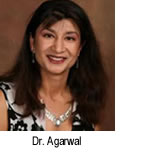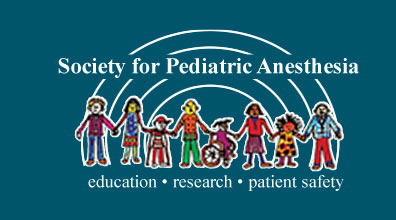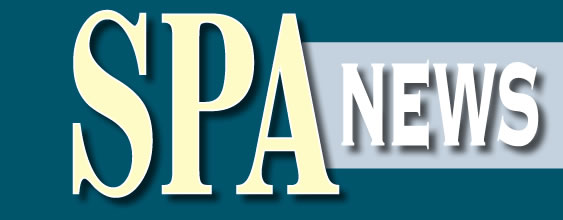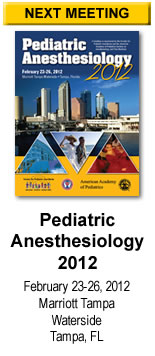International Symposium on the Pediatric Airway 6
Children’s Hospital Colorado, June 17th-19th, 2011
 By Rita Agarwal MD, FAAP
By Rita Agarwal MD, FAAP
ISPA has been held approximately every 3-4 years since 1987 in Pittsburgh, Pennsylvania. It was founded by Dr. Lawrence Borland of The Children’s Hospital of Pittsburgh and moved for the first time to Children’s Hospital Colorado (formerly Denver Children’s) at its new hospital and conference center in June 2011. It has attracted participants from the US, Canada, Europe and South America and has become one of the premier venues for an interdisciplinary exchange of information and new ideas about the airway of infants and children. The meeting was directed jointly by Drs. Larry Borland (Pittsburgh), David Polaner (Colorado) and Geoffrey Lane (Colorado).
Dr. Polaner welcomed the participants on Friday, June 17th and started the conference with a teleconference from Dr. Robert Holzman (Boston) on the embryology of the airway. Dr. Scott Markowitz (Colorado) continued with a lecture titled “Reappraisal of pediatric airway anatomy”. This lecture focused on recent advances in the understanding of airway anatomy in the non-cadaveric patient breathing under anesthesia.
His conclusion was that the vocal cords are the narrowest part of the airway. Much of this work was done using MRI and video laryngoscope imaging. The imaging theme was continued by Dr. Bruno Marciniak (Lille, France) who gave a fascinating talk on the use of various radiologic techniques to diagnosis and plan for the management of the difficult airway. He reviewed MRI, U/S and 3D CT imaging. Truly airway evaluation for a new millennium!
Dr. Andreas Gerber (Zurich, Switzerland) presented the latest research on the utility and safety of cuffed endotracheal tubes in pediatric patients. He concluded that in particular the micro-cuff ETT has few disadvantages and several advantages to the traditional uncuffed ETT in pediatric patients. Even our ENT airway specialist colleagues seemed convinced.
Dr. David Polaner changed tracks with his discussion on the use of real-time monitoring to maximize intra-operative ventilation. He focused on recognizing and treating atelectasis, and interpretation and utility of flow volume loops in the OR.
After lunch, the pulmonary and ENT specialists took over. Dr. Scott Sagel (Pulmonary, Colorado), a world-renowned expert in cystic fibrosis (CF), gave an update on the care and advances in the treatment of CF. Dr. Robin Deterding (Pulmonary, Colorado) presented the institution’s experience with laryngomalacia and tracheomalacia, and the development of an Aerodigestive program. She used cases to illustrate the difficulty with diagnosing and treating these problems.
Dr. Peggy Kelley (ENT) reviewed the surgical and anesthetic concerns for patients undergoing laryngotracheal reconstruction. The afternoon sessions finished with a panel on the treatment and care of the asthmatic patient. Panelists included Drs. Robin Deterding (pulmonologist), Nathan Rabinovitch (allergist) and Judit Szolnoki (anesthesiologist). A lively question and answer session followed.
Saturday, June 18th started with an excellent review of the pathophysiology and treatment of laryngospasm from Dr. Thomas Erb (Basel, Switzerland). Dr. Andreas Gerber (Zurich) stirred up the audience with his controversial presentation on “Cricoid Pressure-Unfavourable and Unnecessary”. Some, but not all the participants were swayed by his arguments and this attendee will probably still continue to use cricoid pressure judiciously. Dr. Greg Allen (ENT-Colorado) gave a fascinating lecture on the operative and non-operative treatment of mandibular hypoplasia. He included a discussion of common causes of micrognathia and the resulting pathophysiologic derangements as well as treatment options.
After a break, Dr. Erb returned to review airway maneuvers in the treatment of upper airway obstruction, with particular emphasis on manual skills: jaw thrust, CPAP and positioning. Dr. Robert Yellon (ENT, Pittsburgh) continued the discussion of airway obstruction by presenting epiglottis and base of the tongue obstruction (EBT). The primary cause of EBT is not well defined and is often a diagnosis of exclusion. Secondary EBT is most commonly caused by mandibular hypoplasia or glossoptosis.
The afternoon started with 2 discussions on dexmedetomidine.
The first lecture by Dr. James Cain (Pittsburgh) described some interesting case situations that dexmedetomidine could be used for, including a teenager with a very difficult airway. Dr. Mohamed Mahmud (Cincinnati Children’s Hospital) presented results of their research of the effects of dexmedetomidine and propofol on upper airway anatomy. He reviewed the evolution of Cine MRI and sleep endoscopy, listed the conditions that needed and the challenges presented by these cases.
Dr. Joseph Dohar (ENT, Pittsburgh) and Dr. Larry Borland (Anesthesiology, Pittsburgh) talked about videolaryngostroboscopy for diagnosis of laryngeal and/or speech abnormalities. Patients need to be able to phonate and breathe spontaneously, so providing appropriate anesthesia can be challenging. The afternoon ended with an interactive panel on Anesthesia Outside of the OR. Drs. Geoffrey Lane (Anesthesiology), Emily Dobyns (PICU) and Timothy Givens (ED), all from Colorado, presented various scenarios and possible solutions. The final session was abstract presentations.
Dr. Monica Abaza (ENT, Colorado) continued the discussion on evaluation of the Larynx on Sunday, June 19th. This was a fascinating look into the function of the larynx primarily in terms of speech. Dr. Norman Friedman (ENT, Colorado) continued with an outstanding lecture on sleep studies and evaluation for surgery. He described the reasons when a sleep study might be advisable (young children, questionable H&P, syndromic children or children with significant comorbidities), what was measured and evaluated, how to interpret these results and finally how polysomnography could help the clinician with peri-operative management.
Dr. David Polaner continued the theme of airway obstruction with an excellent review of medications and their effects on the patient with OSA. He stressed that patients with OSA and hypoxia have increased opioid receptors and therefore need less and have greater sensitivity to administered opioids. A normal dose of opioids in these patients is a relative overdose. Dr. Borland discussed the peri-operative care of patients with Trisomy 21, with a particular emphasis on their airway issues, including adenotonsillar hypertrophy and OSA.
The morning and the conference ended with Dr. Geoffrey Lane describing how to teach and evaluate airway skills in the modern training environment, the impact of a reduced work hours, and increased emphasis on documentation. He reviewed the history of the development of difficult airway equipment and made some suggestions to use high tech evaluation methods (videotaping). He then went on to demonstrate those skills by teaching and running an airway skills workshop.
The meeting was a great success, well attended and educational. Most importantly, it brought together experts from numerous fields with overlapping interests and allowed them a forum to discuss and question their own and each others' concerns. We hope you and your colleagues choose to join us in the summer of 2013 (dates and exact location to be determined). For more information please go to International Symposium on the Pediatric Airway (www.pedsairwaysymposium.org) Handouts, abstracts, faculty information and the program are available for browsing.


